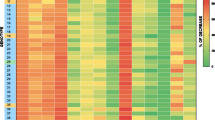Summary
In three experiments the growth of 16 genotypes of tomato was examined. The plants were raised in growth rooms at a day temperature of 19°C and night temperatures of 14, 10 or 6°C respectively under a light intensity of 24 Wm-2 visible radiation and a daylength of 8 hours. The results were analysed by a multivariate analysis of variance.
Relative growth rate (RGR), leaf area ratio (LAR), specific leaf area (SLA) and leaf weight ratio (LWR) decreased with time. The change in net assimilation rate (NAR) was small. The decrease in RGR was mainly due to the decrease in LAR.
RGR, LAR and SLA were lower and LWR slightly higher at lower night temperatures. NAR was hardly affected. The lower RGR at lower night temperatures was mainly due to a lower SLA.
Significant differences between genotypes were found in total dry weight, NAR, LAR, SLA and LWR, but hardly in RGR. Significant genotype × temperature interactions occurred.
LAR and SLA were positively, NAR and LAR, and NAR and SLA negatively correlated.
Similar content being viewed by others
References
Calvert, A., 1964. The effects of air temperature on growth of young tomato plants in natural light conditions. J. hort. Sci. 39: 194–211.
Eagles, C. F., 1969. Time changes of relative growth-rate in two natural populations of Dactylis glomerata L. Ann. Bot. 33: 937–946.
Eagles, C. F., 1971. Changes in net assimilation rate and leaf-area ratio with time in Dactylis glomerata L. Ann. Bot. 35: 63–74.
Garretsen, F. & M., Keuls, 1986. Functions of time for growth characters, their evaluation and approximation to examine differences between genotypes. Euphytica 35: 11–15.
Hammer, P. A. & N. S., Urquhart, 1979. Precision and replication: Critique II. In: T. W., Tibbits & T. T., Kozlowski (Eds), Controlled environment guidelines for plant research. Academic Press, New York, pp. 343–363.
Harssema, H., 1977. Root temperature and growth of young tomato plants. Meded. Landbouwhogeschool Wageningen 77–19: 85 pp.
Hussey, G., 1965. Growth and development in the young tomato. III. The effect of night and day temperatures on vegetative growth. J. Exp. Bot. 16: 373–385.
Keuls, M., 1952. The use of the ‘Studentized range’ in connection with an analysis of variance. Euphytica 1: 112–122.
Keuls, M. & F., Garretsen, 1982. Statistical analysis of growth curves in plant breeding. Euphytica 31: 51–64.
Keuls, M., G. F. P., Martakis & A. H. A., Magid, 1984. The relationship between pod yield and specific leaf area in snapbeans; an example of stepwise multivariate analysis of variance. Scientia Hortic. 23: 231–246.
Paul, E. M. M., R. C., Hardwick & P. F., Parker, 1984. Genotypic variation in the response to sub-optimal temperatures of growth in tomato (Lycopersicon esculentum Mill.). New Phytologist 98: 221–230.
Pet, G. & F., Garretsen, 1983. Genetical and environmental factors influencing seed size of tomato (Lycopersicon esculentum Mill.) and the effect of seed size on growth and development of tomato plants. Euphytica 32: 711–718.
Rajan, A. K. & G. E., Blackman, 1975. Interacting effects of light and day and night temperatures on the growth of four species in the vegetative phase. Ann. Bot. 39: 733–743.
Smeets, L., 1978. The phytotron of the Institute for Horticultural Plant Breeding (IVT), Wageningen, the Netherlands. A revision of previous descriptions. Neth. J. Agric. Sci. 26: 8–12.
Smeets, L. & N. G., Hogenboom, 1985. Introduction to an investigation into the possibilities of using physiological characters in breeding tomato for low energy conditions. Euphytica 34: 705–707.
Thorne, G. N., 1960. Variation with age in net assimilation rate and other growth attributes of sugar-beet, potato, and barley in a controlled environment. Ann. Bot. 24: 356–371.
Thorne, G. N., 1961. Effects of age and environment on net assimilation rate of barley. Ann. Bot. 25: 29–38.
Author information
Authors and Affiliations
Rights and permissions
About this article
Cite this article
Smeets, L., Garretsen, F. Growth analyses of tomato genotypes grown under low night temperatures and low light intensity. Euphytica 35, 701–715 (1986). https://doi.org/10.1007/BF00028578
Received:
Issue Date:
DOI: https://doi.org/10.1007/BF00028578




